Make Sure Your Child Gets to School Safely - Walk, Bike, or Drive

Depending on where they live and their home situations, many children only have one way to get to school. Others may have more options. Whether kids get to school by car, bus, walking, or biking, adults are responsible for setting up a transportation plan and teaching their children how to stay safe on their way to class.
A good transportation plan requires knowing when kids are old enough to travel alone, mapping safe routes to school, and teaching them how to behave on and near various types of vehicles. It is also critical that children know when to interact with and avoid strangers, as well as what to do if they sense danger. Read on to learn more.
Bus Safety
Accompany your child to the bus stop the first few times to teach them proper safety precautions. There are many tips you can pass along to your child to help keep them safe around school buses, such as:
- Waiting at the bus stop instead of lingering elsewhere before the bus arrives.
- Waiting at least 10 feet away from the bus.
- Waiting for the bus to come to a complete stop before approaching it.
- Not chasing the bus if they miss it.
- Listening to the bus driver and staying seated.
- Walking along a sidewalk or well within the street margin for at least 10 feet before crossing in front of the bus.
- Making eye contact with the bus driver before crossing in front of the bus.
If the bus stop is not in front of your home, walk your children along the proper path and teach them how to stay safe near roads.
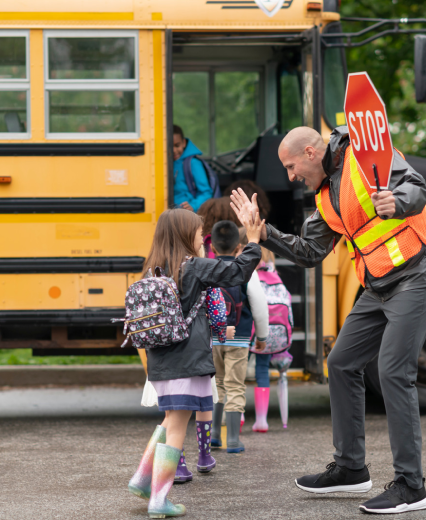
Why Are School Buses Safe?
School buses are safer than most other methods of transportation to school. They are highly visible, and other drivers must obey various laws designed to keep school buses safe and prevent bus accidents, such as not passing them during loading and unloading. Further, bus drivers are trained to keep passengers safe, and the buses they drive have built-in safety features not present in most other vehicles.
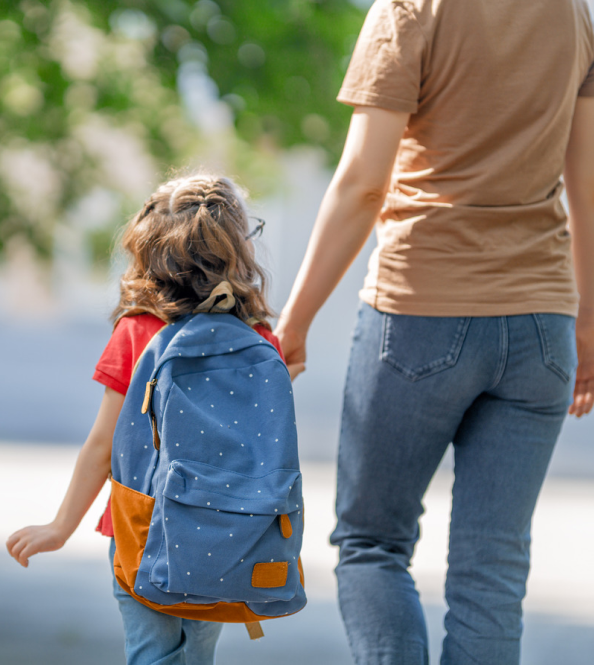
Walking to School
Walking to school is a great way for kids to get some exercise and become more independent, but it can also be dangerous. There are many safety tips you can pass on to your children who walk to school, including:
- Look both ways before crossing a street and avoid crossing where parked cars, overgrown bushes, or other objects prevent drivers from seeing them.
- Always use crosswalks, and do not start walking until you see that approaching vehicles are safely coming to a stop. Drivers often only look for nearby traffic when turning and can easily miss pedestrians in crosswalks, especially children.
- Wear bright clothing or carry a bright backpack to increase visibility.
- Never use cell phones or headphones when walking to school. They reduce your ability to hear traffic and notice signs of danger.
- Always follow directions from crossing guards and obey crosswalk laws.
- Walk with other kids when possible, especially if they also have an adult with them.
How Do I Know if My Child Is Ready To Walk to School?
Parents, another adult, or an older sibling should walk to school with children until they are at least 10 years old, as younger children may not fully understand the importance of taking safety precautions and staying vigilant. Walk the path to school several times with your child, explaining safety rules and demonstrating by following them yourself.
Safety in numbers is a useful principle. If possible, find other children in your neighborhood to form a pod and walk to school with your child.
If you are hesitant about letting your child walk to school, try to find another way to get them there. Some kids, especially younger ones, are more impulsive or prone to distraction than others, so it is often best to wait before letting them walk alone.
Biking to School
Before you let your child bike to school, ensure their bike has all the proper safety equipment, including reflectors and well-maintained brakes. At certain times of the year, children may bike to and from school in the dark.
Test the bike’s safety before allowing your child to ride it to school each day. It must be in good working order, with proper tire inflation and brakes. It should also be the proper size so your child can easily control it.
Your child should always wear a properly fitted bike helmet. Have them try several helmets until you find the right one. It should sit level on the head, approximately halfway down on the forehead, and above the eyebrows.
Adjust the sliders on both straps to ensure a secure but comfortable hold. The buckle should sit snugly under the chin so no more than one or two fingers can fit beneath. Have your child test the helmet before they leave. It is not tight enough if they rock their head and the helmet slips over their eyes or to the sides.

Bike Lanes and Sidewalks: Which Is Better?
The decision to use bike lanes versus sidewalks depends on the path to the school. Bike lanes on busy streets filled with cars moving at high speeds may be unsafe for most children. In particular, young children who may not be able to react quickly should ride on sidewalks. Biking is likely not the ideal solution for children under a certain age. Also, be sure to check local ordinances regarding bicycles on sidewalks.
Drive the path your child will take on their bike, judging the traffic and conditions yourself before deciding. If possible, ride a bike with them on potential routes several times. Teach your children proper hand signals for turning and stopping. If your child is too young to use hand signals without losing control, they should ride on the sidewalk to further prevent a potential accident with a car while on their bike.
Mapping the Safest Walking and Biking Route to School
Check your school district’s website or ask someone at the school if they participate in the Safe Routes to School program. These programs are collaborative efforts involving parents, police, schools, transportation officials, and others to map out safe walking and bike-riding paths to school and identify dangerous areas.
If you are planning a trip for your child, try out the options yourself. Once you have chosen a safe path, make the trip several times with your child until they know it well. These trips provide a great chance to discourage shortcuts and tempting places to stop or veer off course.
Point out specific areas to avoid, such as streets with high speed limits or poor safety markings. If you can build a route that includes the homes or businesses of people you trust, point those out to your child. If they sense danger, get a flat tire, run into bullies, or encounter another problem, they will know exactly who to call or where to go.
Driving or Riding to School
Parents must take precautions to ensure their children’s vehicle safety and protect other kids on their way to and from school. There are many ways to promote safe riding:
- Use only designated drop-off zones and avoid double parking that forces your child to pass between cars.
- Children should always get out of the car on the side away from traffic, usually the right side of the vehicle.
- Drivers should keep their eyes peeled in and near school zones, driving safely and slowly.
- Children should ride in the back seat until they are at least 12 years old.
- Small children must always be in car seats. Once they outgrow them, parents can switch to booster seats. Children should stay in booster seats until they are at least 4 feet 9 inches tall and 8 to 12 years old. They are not ready if they can easily slide out of a regular lap-and-shoulder belt on its tightest setting.
- Drivers should be careful around buses and exercise caution at intersections with bus or train stops close to schools.
- Like their children, drivers must always follow the directions of school crossing guards.
- Take extra caution when driving through inclement weather
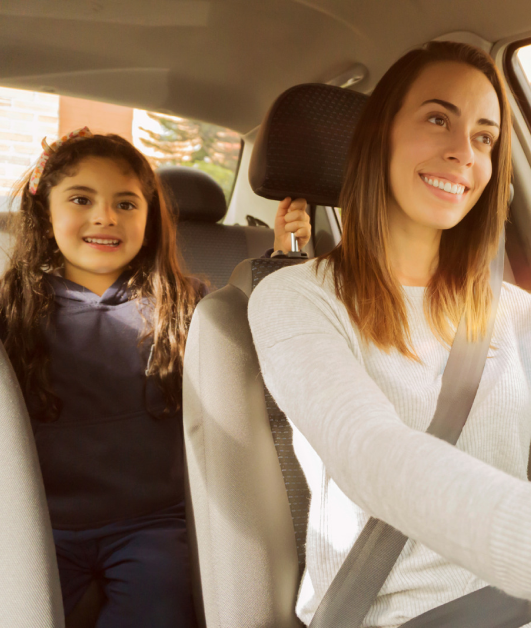
Stranger Safety

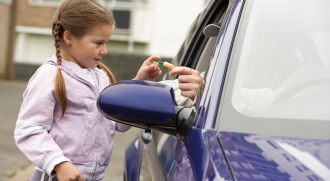
In the past, people warned children about “stranger danger.” Those warnings were well-intentioned but didn’t go far enough to keep children safe. Knowing which strangers to approach can actually help protect kids against dangerous strangers.
From a young age, explain to your children that you can’t tell if someone is safe to approach just by looking at them. Do not instill the sense that all strangers are bad, as they may have to rely on one for help if they are lost or afraid of someone who actually is dangerous.
Teach them about safe strangers, such as police and firefighters or other people accompanying children. On the way to school, show them businesses or homes with people you know and trust to watch over your child. Discuss potentially dangerous situations in which strangers:
- Encourage them to disobey their parents
- Ask them to keep secrets
- Stop them to engage in conversation
- Ask them to go anywhere
- Ask them for help
You can also teach your children “No, Go, Yell, Tell.” If they feel unsafe, they scream “NO!”, run away, yell at the top of their lungs, and tell a trusted adult what happened as soon as possible.
Other Tips for Parents
Making trips to school safer for children involves more than planning their transportation. There are many other things parents can do to help keep children free from harm while traveling to and from school:
- Ensure your child has proper clothing for weather conditions and wears something bright if they are walking or biking.
- Make it clear that “horsing around” isn’t safe when walking, in a car, on a bike, or on a school bus. Distractions often lead to accidents.
- Make sure your child knows your phone number and other important contacts.
- Get your child a form of ID to keep on them at all times. Tell them to only show it to trusted adults.
- If your child takes public transportation, talk to them about additional safety tips. Include the same precautions they would take on or around a school bus, as well as when standing behind safety markers at train stations.
- Give your child a clear plan on what to do if they miss their stop and take a test trip with them so they fully understand what to do.
- Evaluate your child’s school transportation plan regularly to determine if safer options are available.
- Ask your child if anything on the way to and from school makes them feel unsafe.
Trust your instincts when it comes to keeping your kids safe. You know them better than anyone and understand how to respond in specific circumstances. Always err on the side of caution, even if it means more than one argument with your child eager to grow up. Rules are in place to keep them safe—that is your primary concern.
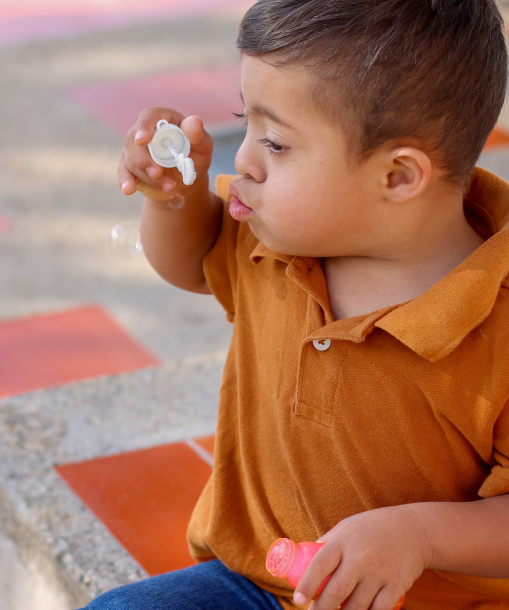
Children With Special Needs
Under the Individuals with Disabilities Education Act, or IDEA, schools must provide transportation for special needs students who cannot use other transportation options. Children with Individualized Education Plans, or IEPs, tailored to their needs are eligible for free transportation if deemed necessary under their plan.
This could include back-and-forth school transportation and between schools if your child attends another specialized school for part of the day. You can find more information about how your state implements IDEA using this interactive map.
Plan for safety based on your child’s unique needs. Ask teachers what they think of your plan. They may have helpful suggestions.
Talk to your child’s doctor about how their needs affect their ability to travel safely to school. Talk to other parents of children with special needs to ask about their experiences. Nonprofit organizations, such as the Special Needs Network, and local meeting groups are also good sources of information.
Help Ensure Your Child’s Safety on Their Way to School
Ensuring your child’s safety during their journey to school, whether they walk, bike, or ride, is one of the most important things we can do. By mapping out safe routes, adhering to transportation safety guidelines, and teaching children how to handle encounters with strangers, parents can foster a safe trip. Ultimately, sufficient planning and open communication about potential dangers and safe practices are an important piece of making every school commute as safe as possible for every child.
